THE CLASSIC HORROR FILM
By Jeffrey-Baptiste Tarlofsky
By Jeffrey-Baptiste Tarlofsky
Lesson 10 consists of four video lectures and transcripts of those lectures, and three film excerpts. Start with Video Lecture, Part 1 and continue down the page in sequence until you reach the end of the lesson.
レッスン10は4本のビデオレクチャーと3本の動画で構成されています。
このレッスンは、最初にビデオレクチャーを見てください。そして、ページをスクロールダウンしながら順番に動画、ビデオレクチャーを見たりテキストを読んでください。
Part 1 – Bela Lugosi’s Dracula, in contrast to Quasimodo, Erik and Gwynplaine, is a monster who wasn’t the slightest bit ugly, (although he could be very scary). In fact, after the release of Dracula Bela Lugosi, (who was actually quite shy around women) received thousands of fan letters from women who thought he was incredibly handsome and sexy. Many of these letters included invitations for Lugosi to visit the ladies late at night with remarks like “the window will always be open” or more directly “please, bite me on the neck!” This was a new kind of monster. Indeed, Lugosi’s Dracula was a suave, handsome, well-dressed gentleman monster who remained cold and emotionless as he killed.
The audience did not scream when they first saw him as they did when they first saw the Phantom’s face, but they did recoil as his performance unfolded. His vampire was also nothing like any other vampire seen before such as Max Schreck’s Count Orlock with his long claw-like hands and ratlike teeth or Lon Chaney’s grinning vampire with his mouth full of shark like teeth. Lugosi’s Dracula has no claws, no vampire fangs and he used almost no make-up. Lugosi relied entirely on the power of his performance. As he said in interviews years later ‘It was all in the eyes and the hands”. Indeed, it was. It was his performance that saved this otherwise poorly made movie.
However, there was a problem with Dracula as a character and this was not the fault of Bela Lugosi, or Tod Browning or the screen writer for the film, Garret Fort, or the playwrights Hamilton Deane and John L. Balderston. The fault went all the way back to the novel by Bram Stoker. Unlike, the novels upon which The Hunchback of Notre Dame, The Phantom of the Opera and The Man Who Laughs are based, Bram Stoker’s novel does not explain the character. Stoker does lead us to believe Dracula is the historical Vlad IV who was a fifteenth century ruler of the principality of Wallachia notorious for his cruelty, but he never explains how or why this man became a vampire.
E. Elias Merhage put that very question into the mouth of his character Albin Grau, the producer of Nosferatu, in his film Shadow of the Vampire, which is the fictional retelling of the story of how Nosferatu was made. Here is that crucial scene again.

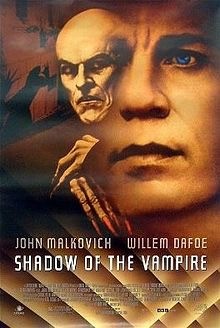
Directed by E. Elias Merhige
Produced by Nicolas Cage and Jeff Levine
Written by Steven Katz
Starring John Malkovich and Willem Dafoe
Running time: 92 minutes
Part 2 – The question was, “How did you become a vampire?“ and the answer is somewhat vague. Schreck answers, “It was woman!” and the writer, Henrik Galeen, laughs and says, “Ah, now we’re getting somewhere”. He laughs because men are supposed to believe their problems are caused by falling in love with women. But as Schreck tries to explain what happened all he can remember is that “we were together in the night…” and then somehow they were not. He has had paintings and sculptures of his beloved, but as his existence has decayed so have these. Now, even his memory of her is gone. No wonder this vampire drinks! He is utterly miserable and it does seem to have all started with his love for a woman.
In Shadow of the Vampire, we never learn any more about his past, but there is a film that answers all these questions about Dracula. It is a film I consider to be by far the best modern adaptation of the Dracula story. It is called Bram Stokers’ Dracula (1992) and it was directed by the legendary Francis Ford Coppola.
Excuse me , but I simply cannot resist telling you a story about Coppola…and me. Coppola made his great Vietnam war film, Apocalypse Now, in 1977, shortly after the end of the Vietnam War. For some reason the film became very popular in Vietnam itself in the 1990s, so much so that the country’s most famous nightclub was named after the film. I went to visit Vietnam in 1997 and was in the capital city, Hanoi, in February. It was a cold a rainy day so I decided to escape the bad weather and warm up in the Press Club bar (Image #1).
I went in and sat down and ordered a double whiskey and a cigar (Cuban, of course). I was the only person in the bar. As I was sitting there, people started to peak at me from around corners and through windows. I thought, “Well, I guess they don’t get that many Westerners here”. After all, Japanese were still doing that to me in 1987 when I arrived in Japan. But then the manager came into the room and approached me with a huge smile and said,
“Oh, sir, they told me you were here”.
“Yes…”, I said getting nervous, “Here I am”.
“It’s an honor, sir”, he said.
“Oh…well…”, I said, wondering to myself who the hell does he think I am?

Image #1

Image #2
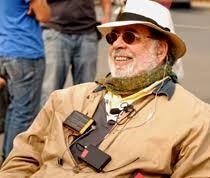
Image #3
The manager then told everyone to stop staring and go back to work, shook my hand and said “So sorry to have disturbed you, sir” and was off. Of course, the whiskey and cigar were compliments of the house! It was only after I returned to Japan that I read about Coppola being in Hanoi the same time I was for the twentieth anniversary of the filming of Apocalypse Now. How could anyone make such a mistake Please see Images #2 and #3 above.
Please vote for the one you think looks more like Francis Ford Coppola.
Coppola is best known for directing The Godfather, Parts 1 and 2, Apocalypse Now and Bram Stoker’s Dracula. The first three films are all ranked in the top 50 greatest films ever made by both Sight and Sound magazine and the American Film Institute. Perhaps Bram Stoker’s Dracula is not quite as perfect as these first three, but it certainly stands as the best interpretation of the Dracula story ever filmed (in my humble opinion). One reason I judge this film so highly is for the simple reason that it at long last answers the question: “How did the man become a vampire?” Coppola answers that question in the first ten minutes of his film, which we shall see in Excerpt #2.
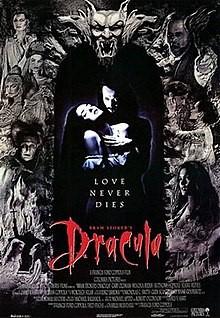
Directed by Francis Ford Coppola
Produced by James V. Hart (Based on a revisioning of the novel by Bram Stoker)
Starring: Gary Oldman, Keanu Reeves, Anthony Hopkins and Winona Ryder
Budget: $40,000,000
Running Time: 128 minutes
Part 3 – So, it was a woman! Coppola turns Bram Stoker’s tale of a bloodthirsty vampire into one of a man who was protecting his country, his people and his religion, but more than anything else he turns Dracula into a love story in which Dracula has lost his beloved. The loss of his beloved wife, Elizabeta has not driven him insane, it has driven him to evil because he feels that he has been betrayed by God. Why did he feel betrayed? His wife, Elizabeta, believed he had died in battle and killed herself in despair. It is rather difficult for Japanese to understand what is going on here because in ancient Japan this is exactly what a Japanese noble lady would have done.
The key here is understanding that in Japanese society suicide is not forbidden, though it is a tragedy. No one thinks suicide is good or wished to commit suicide, but in Japan suicide was never considered a sin, i.e., forbidden by religion. Under the right conditions, suicide in ancient Japan was the only honorable option a person might have. In contrast to this, in the Judeo-Christian tradition, suicide is considered a serious sin by both Jews and Christians. The thinking is that God gave life to human beings and it is not for them to disregard this gift.
Therefore, when Dracula returns to the castle to find Elizabeta’s body, the priest tells him that her soul cannot go to heaven because she has committed suicide. You saw Dracula’s reaction. He goes absolutely nuts. He asks, “Why have I spilled all this blood for a God who denies me the one thing I love?” Then, in a moment that I have to say really scares anyone raised in the Judeo-Christian tradition, he renounces God and calls on the powers of darkness. Dracula is switching sides. I don’t mean he will fight for the Ottoman’s, either, because they also believed in and fought for the same God under a different name. Dracula is now taking Satan as his new master. Who is that? You are going to read all about Satan for your homework reading.
Coppola called his film Bram Stoker’s Dracula, but that title is deceptive because Coppola does not tell the story as Bram Stoker wrote it. Instead Coppola answers the questions Stoker left unanswered in his book. By so doing, Coppola solved one of the great mysteries of horror and made the Dracula character far more complete than he had ever been in any other film. Of course, Coppola also changed the story completely. His film is what we call a remake. Remakes are films that attempt to retell the same story an earlier film told, but remakes also often change the stories. Remakes are almost never as good as the original films on which they are based. But sometimes, very rarely, the remake is better than the original. Of course, no one will ever be a better Dracula than Bela Lugosi, (not even Gary Oldman) but Francis Ford Coppola’s film is a far better film than the original Dracula (1931).
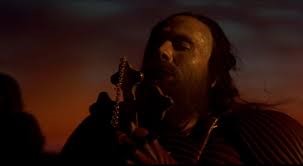
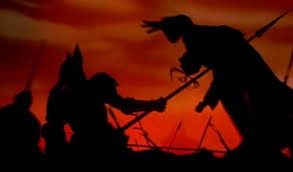

In Coppola’s film, it is clear that Dracula chose to become a vampire. The question of choosing to become a vampire is fascinating indeed and brings us to yet one more film. Two years after Coppola’s Bram Stoker’s Dracula was released, another film based on a very popular vampire novel was also released. The film was Interview with The Vampire (1994) and in it a character is faced with a terrible choice.

Directed by Neil Jordan
Produced by David Geffen, Stephen Woolley
Screenplay by Anne Rice (Based on Interview with the Vampire by Anner Rice)
Starring: Tom Cruise and Brad Pitt
Running Time: 122 minutes
Budget: $60 million
Box Office: $223.7 million
Part 4 – In conclusion, the reason we are not doing quite as much in lecture and film excerpts this week is because I have a rather long reading assignment for you to do which is important for you to understand as we go forward with our study of not just Dracula and other vampire films, but other horror films we will be studying next semester as well.
In addition to the reading homework, I would also like each of you to consider the choice the vampire Lestat (Tom Cruise) gave Louis (Brad Pitt). The choice was “will you agree to become a vampire like me or do you choose to die?”. There is absolutely no chance for you to escape this vampire or kill him, so you only have those two choices. By the way, the vampire obviously doesn’t have to give you a choice, of course. He is being…well, nice. Really give this some thought and write those thoughts down in your notes.